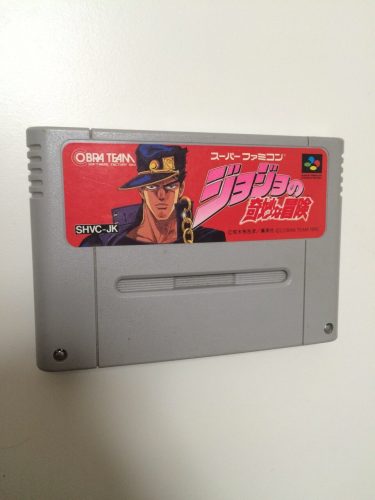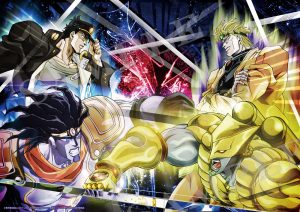
As we concluded in part 2, not only did the franchise take influence from pop culture in context to music, it was also an influence on video games. Thanks to the popularity of the present anime, exposure and marketing JoJo games for an international audience is now easier than ever. Due to copyright issues, names have to be changed for overseas markets (like in the anime). PS3’s All-Star Battle, which was released in 2013 in Japan (and released in 2014 outside of it) got a 40/40 in Famitsu, which is (almost) hard to achieve! The following year, we got Eyes of Heaven. Though both of these fighting games feature characters from ALL story arcs, that was never the case with its predecessors. So beyond these two games, we thought this time, it would be best to explain JoJo in gaming.
Super Famicom
While the PS3/PS4 releases have achieved international recognition, the first game based on the JoJo series was released on March 5, 1993 for the Super Famicom. It was a J-RPG based on Stardust Crusaders. It was developed by Winkysoft, who originally made the Super Robot Wars games. As unbelievable as this sounds, the game was produced by Shinji Hashimoto, who some of you may know as the co-creator to Kingdom Hearts.
As to how this game works, it is very distinct from the RPGs of its time with more of a point and click/side-scrolling exploration, and with a battle system somewhat similar to Dragon Quest but with its own unique distinctions. There are no random fights and they’re pre-determined based on where you advance in the story. The battle system is unique where upon beginning, Dio shows up and has you choose 5 tarot cards facing down. Based on what you pick, it could either help or hurt your party. Though the game has its standard HP and MP meter, MP this time doesn’t represent magic, but mental. One of the options you have in this game is to “talk” to your opponents and the talking is just mostly trash talk that can affect the mental points.
In context to the story, there are some notable changes/removals from the original source material. For starters, Steely Dan is non-existent in the game and despite Kakyoin, Avdol and Iggy dying in the manga/anime, they survive in the game.
The Capcom 2D Fighter
As unbelievable as this sounds, JoJo’s first international exposure was through its Capcom 2D fighter. It was released in 2000 in North America for the PS1 and Dreamcast. Like the Super Famicom RPG, this fighter uses the story and characters from Stardust Crusaders (though Young Joseph is a secret character and Wang Chan does have a cameo). If you’re familiar with most of Capcom’s fighters, then this is easy to pick up but with some twists.
Appropriately, you can activate Stands at the push of a button. While it is simple for fighting game enthusiasts to pick up, it has its own distinguishing features that make it stand (no pun intended) out in order to master. One notable feature is the Blazing Fists Match (which is featured in All-Star Battle), which is probably most notable when you have Dio and Jotaro fighting each other. If they perform a certain move at the same time, then their fists will collide and it becomes a button mashing contest.
The PS1 release has its own unique set of exclusive interactive scenes which feature Gray Fly, Enya, and the fake Captain. In addition, there is a side scrolling shooter mini game involving Steely Dan. For the Dreamcast release, it has an Alessi Mode meaning you can play the characters as children. Overall, what makes this game captivating in canon is that it officially provides a design to Midler, who we never see other than a vague corpse in the manga/anime. In the game, Araki provided a design for her to look like an exotic belly dancer.
As to why this game got a North American release, after Capcom found success exposing Japanese audiences to American comic heroes through Marvel Vs. Capcom, they thought they could help make Japanese manga characters famous by releasing JoJo.
Phantom Blood and Golden Wind
Midway into the 2000s, there were two JoJo games for the PS2 which were based on Phantom Blood and Golden Wind. They served as cel-shaded action/adventure games which were paved way by Sega’s Jet Set Radio. In 2002, Capcom released a game based on Golden Wind. They felt cel-shaded graphics were the best way of representing the style of the manga. In this game, you can play as all members of Bucciarati’s and fight the evil forces of Passione in one-on-one free roaming battles. Capcom actually wanted to release Golden Wind in the US but due to Araki not wanting to comply with copyright issues, it was canceled.
In 2006, the rights of the franchise transferred to Bandai Namco and they released their own JoJo game based on Phantom Blood. Though the Phantom Blood movie was criticized for removing Speedwagon (amongst other things), this game does a great job of bringing the character back and re-creating most of the manga’s story. The nature of the battle system is no different from Golden Wind but as opposed to having Stands (which of course had yet to be introduced), you can use the Hamon, and when a power gauge is full, you can use an Overdrive attack! Plus, you can do poses!
Final Thoughts (All-Star Battle and Eyes of Heaven)

Thanks to the advancement of technology and where the franchise is now, we can now have games that feature characters from all story arcs. Plus, post-2000s technology can also give us games that can represent the manga’s style. However, one major inconsistency has been the voice cast and we thought for the next part of JoJo Explained, we can explore the dialog and acting of the series.
To Be Continued...
Recommended Post
JoJos Bizarre Adventure (JoJo no Kimyou na Bouken)
Recommended Post



